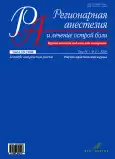Программированный интермиттирующий эпидуральный болюс (pieb) для обезболивания самопроизвольных родов: исследование динамики сенсорного блока и влияния на моторную функцию
- Авторы: Упрямова Е.Ю.1, Шифман E.M.2, Краснопольский В.И.1, Овезов А.М.2
-
Учреждения:
- ГБУЗ МО «Московский областной научно-исследовательский институт акушерства и гинекологии»
- ГБУЗ МО «Московский областной научно-исследовательский клинический институт им. М.Ф. Владимирского»
- Выпуск: Том 14, № 2 (2020)
- Страницы: 63-71
- Раздел: Оригинальные статьи
- URL: https://journals.rcsi.science/1993-6508/article/view/55467
- DOI: https://doi.org/10.17816/1993-6508-2020-14-2-63-71
- ID: 55467
Цитировать
Аннотация
Актуальность. Техника программированного интермиттирующего болюса (PIEB) для обезболивания родов демонстрирует определённые преимущества перед стандартно применяемыми вариантами эпидуральной анальгезии (ЭА). Целью исследования явилась сравнительная оценка динамики моторного и сенсорного блока у рожениц, обезболенных техникой PIEB и традиционными режимами ЭА (болюс, PCEA, CEI + PCEA, PIEB + PCEA).
Материалы и методы. Проспективное исследование эффективности обезболивания различных режимов ЭА родов у 165 рожениц. Степень моторного блока определяли в баллах по классической шкале Bromage (0-1-2-3). Уровень сенсорного блока оценивали с помощью теста «pin-prick». В зависимости от режима введения и концентрации местного анестетика все роженицы были разделены на 5 групп: ручные болюсы по требованию, PCEA, PCEA + CEI, PIEB + PCEA; левобупивакаин 0,25 мг/мл; 1,25 мг/мл; 0,625 мг/мл. Эффективность обезболивания родов оценивали с помощью ВАШ. Временные точки регистрации значений: через 15 мин от начала обезболивания, затем каждые 30 мин до полного раскрытия маточного зева.
Результаты. Наибольшая частота МБ (Bromage 1) наблюдалась в группе 1 к 120-й мин у 80% пациенток. Сходная по значению относительная частота МБ получена в группе 2 и 3 к 150-й мин. В группе 4 через 15 мин после обезболивания частота МБ составляет примерно 6%, нарастая до 40% к 240-й мин. В группе 5 относительная частота МБ сохранялась на нулевой отметке до 120-й мин, а затем не превышала 10%, к 240-й мин частота МБ снова снизилась до 0% (р < 0,00001). Уровень сенсорного блока у пациенток в группе PIEB был выше уже через 15 мин после начала обезболивания и оставался таковым до конца периода наблюдения (медиана PIEB Th5 против Th8 в группе CEI (р < 0,0004).
Выводы. Эпидуральная техника PIEB + PCEA поддерживала стабильно высокий уровень сенсорного блока на протяжении всего исследования по сравнению с PCEA + CEI, что обеспечило эффективную анальгезию в I и II периодах родов с минимальной частотой развития МБ.
Полный текст
Открыть статью на сайте журналаОб авторах
Екатерина Юрьевна Упрямова
ГБУЗ МО «Московский областной научно-исследовательский институт акушерства и гинекологии»
Автор, ответственный за переписку.
Email: katerinaupryamova@gmail.com
ORCID iD: 0000-0002-7057-2149
к. мед. н., руководитель отделения анестезиологии и интенсивной терапии
Россия, 101000, МоскваE. M. Шифман
ГБУЗ МО «Московский областной научно-исследовательский клинический институт им. М.Ф. Владимирского»
Email: katerinaupryamova@gmail.com
ORCID iD: 0000-0002-6113-8498
Россия, 129110, Москва
В. И. Краснопольский
ГБУЗ МО «Московский областной научно-исследовательский институт акушерства и гинекологии»
Email: katerinaupryamova@gmail.com
Россия, 101000, Москва
А. М. Овезов
ГБУЗ МО «Московский областной научно-исследовательский клинический институт им. М.Ф. Владимирского»
Email: katerinaupryamova@gmail.com
ORCID iD: 0000-0001-7629-6280
Россия, 129110, Москва
Список литературы
- Упрямова Е.Ю., Шифман Е.М., Краснопольский В.И., Овезов А.М. Программированный интермиттирующий эпидуральный болюс (PIEB) для обезболивания самопроизвольных родов. Анестезиология и реаниматология. 2020;4:68-76. doi: 10.17116/anaesthesiology202004169
- Xu J., Zhou J., Xiao H., Pan S., Liu J., Shang Y., Yao S. A Systematic Review and Meta-Analysis Comparing Programmed Intermittent Bolus and Continuous Infusion as the Background Infusion for Parturient-Controlled Epidural Analgesia. Sci Rep. 2019;22;9(1):2583. doi: 10.1038/s41598-019-39248-5.
- Carvalho B., George R.B., Cobb B., McKenzie C., Riley E.T. Implementation of Programmed Intermittent Epidural Bolus for the Maintenance of Labor Analgesia. Anesth Analg. 2016;123(4):965-71. doi: 10.1213/ANE.0000000000001407.
- Нейроаксиальные методы обезболивания родов. Клинические рекомендации (протокол лечения). Одобрены МЗ РФ № 15-4/10/2-6914, 2018.
- Curatolo M., Petersen-Felix S., Arendt-Nielsen L. Assessment of regional analgesia in clinical practice and research. Br Med Bull. 2005;31;71:61-76. doi: 10.1093/bmb/ldh035
- Wang T., Shen S., Shao-Qiang H. Effects of Epidural Labor Analgesia With Low Concentrations of Local Anesthetics on Obstetric Outcomes. Anesth Analg. 2017;124(5):1571-80. doi: 10.1213/ANE.0000000000001709
- Sultan P., Murphy C., Halpern S., Carvalho B. The effect of low concentrations versus high concentrations of local anesthetics for labour analgesia on obstetric and anesthetic outcomes. Can J Anaesth. 2013;60:840-54. doi: 10.1007/s12630-013-9981-z.
- Barbé A., Roofthooft E., Devroe S., Van de Velde M. Programmed intermittent epidural boluses (PIEB) in labor analgesia: a narrative review of the present. Acta Anaesth. Belg. 2019;70:11-21.
- Xu J., Zhou J., Xiao H., Pan S., Liu J., Shang Y., Yao S. A Systematic Review and Meta-Analysis Comparing Programmed Intermittent Bolus and Continuous Infusion as the Background Infusion for Parturient-Controlled Epidural Analgesia. Sci Rep. 2019;22;9(1):2583. doi: 10.1038/s41598-019-39248-5.
- Gabriel L., Young J., Hoesli I., Girard T., Dell-Kuster S. Generalisability of randomised trials of the programmed intermittent epidural bolus technique for maintenance of labour analgesia: a prospective single centre cohort study. British Journal of Anaesthesia. 2019;123(2):e434-e441. DOI:https://doi.org/10.1016/j.bja.2019.02.016
- Hogan Q. Distribution of solution in the epidural space: examination by cryomicrotome section. Reg Anesth Pain Med. 2002;27(2):150-6.
- Capogna G. Maintenance of labor analgesia. In: Epidural Labor Analgesia: Childbirth Without Pain. Switserland. Springer. 2015;89-101.
- Kenichi Ueda, Wasa Ueda, Masanobu Manabe. A Comparative Study of Sequential Epidural Bolus Technique and Continuous Epidural Infusion. Anesthesiology. 2005;103(1):126-9. doi: 10.1097/00000542-200507000-00019
- Kaynar A.M. Shankar K.B. Epidural infusion: continuous or bolus? Anesth Analg. 1999;89(2):534.
Дополнительные файлы












